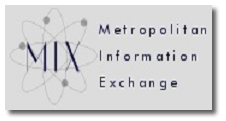The Metropolitan Information Exchange (MIX), an association of City and County
CIOs, met in Seattle this week. MIX is a select group of 55 forward-thinking technology leaders. Their discussions about the future uses of technology in government have been quite enlightening.
For the most part, these are mid-sized cities and counties, almost all with populations of 100,000 or more. These Chief Information Officers (CIOs) share at least one passion: making information technology work in service to the government and people of their communities.
Many of these jurisdictions have award winning government websites – Las Vegas, Riverside, Wake County (North Carolina), King County (Washington) and Yuma County (Arizona) each were among the five top web portals in eRepublic’s 2008 competition. Others – such as Seattle and Tucson – have top municipal television channels. Still others have cutting edge implementations of a wide variety of technologies, ranging from the 35,000-public-safety-radio network operated by Harris County (Texas) to the Second Life experiments of Nevada County (California) to the City-wide Wi-Fi network operated by Corpus Christi.
Web 2.0 was the subject of this conference. All of us working in government technology know Web 2.0 is leading edge. But Web 2.0 is really “icing” on our government technology “cakes”.
The core, first layer of IT in government is infrastructure – networks, computers, data centers. That infrastructure has to be rock solid and operating 24 hours a day, seven days a week because local government delivers service all day, every day.
The second layer of our “cake” is the applications, built upon the infrastructure, which provide efficiency and effectiveness for government. These applications include mapping, utility billing systems, financial management, computer-aided dispatch and many others.
The third layer of our IT “cake” is a wide variety of ways government employees and constituents use the technology to request and render services or provide information. These methods include interactive voice response systems, television channels and the websites of our jurisdictions.
Web 2.0 is the “icing” in one sense, because it is so leading edge (for government). In another sense, web 2.0 technologies are the essence of government. Web 2.0 is about collaboration. It is about social networks. It is about building community. And that – building community – is what government is all about – collaboration and making our communities stronger.
How are governments using Web 2.0 technology? I have a detailed set of examples here (and welcome feedback with more samples). Some highlights:
- Some elected officials are blogging, but only a few regularly write – Tim Burgess of Seattle and Walter Neary of Lakewood (Washington) are two examples.
- Chicago Police is doing a great mashup and display of detailed crime statistics by address or ward, around schools and parks.
- Montgomery County, Pennsylvania, is making extensive use of wikis to improve information sharing among county departments.
- The Seattle Channel is doing podcasting and interactive television with its Ask-the-Mayor program for Mayor Greg Nickels – viewers can call or e-mail real-time and there are video-taped questions.
- A very few governments have YouTube channels, e.g. Mountain View/Los
Altos California, although constituent video of local government
meetings appears to be a more popular use of YouTube, such as Somervell
County, Texas. - Some cities and counties have Facebook or Myspace pages, e.g. Prince William County, Virginia, which uses MySpace for recruiting. MIX, itself, has a LinkedIn group.
- But I’ve not seen local government effectively use social networking yet. Fertile ground for innovation!
In short, we in MIX – and other local government CIOs – are concentrating on keeping the core of information technology networks and systems running well in our governments. And we are experimenting with a wide variety of Web 2.0 and similar technologies which we know will make government more collaborative and interactive.




As a member of MIX, I second Bill’s “icing” analogy. Today, Web2.0 as a concept and a set of technologies is certainly not core to our operations. Yet, as you look at 2.0 integration in business, in university curriculums and in our networks and communications outside of work, it is clear that we should all be at least familiar with where things seem to be going and who is doing what.
Certainly we don’t all need to rush out and start twittering or creating avatars in Second Life. However, I think it would be a good use of our time to network and explore what our peers are doing and perhaps try a few small controlled experiements in our own organizations. Perhaps one of the most appealing aspects of most Web2.0 technologies is that you can implement them with little to no expense (other than time) or infrastructure requirements. Most solutions are hosted and easy to establish and use. So you can try things out and if they don’t seem right for your organization or goals, no big deal – just pull the plug and look for something better!
If you are interested in collaborating with other local governments interested in the Web2.0 wave, I have established a collaboration site to share Web2.0 ideas in local govt. (https://sites.google.com/site/munigov20/) The group consists of local government members from across the country who are actively investigating and/or implementing the Web2.0 stuff. The site is not complete yet, but it is growing rapidly so i’d encourage anybody interested to check it out.
Bill Greeves
IT Director
Roanoke County, VA
skype: bill.greeves
Twitter: http://twitter.com/bgreeves
LinkedIn: http://www.linkedin.com/pub/9/9a9/100
Second Life: Greever Wemyss